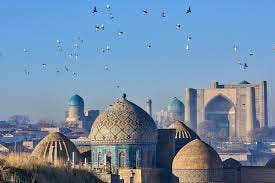Before anything else, I figured I should write a post here introducing Uzbekistan and saying something about where I’ll be, how I ended up here, and what I’ll be doing both in Uzbekistan and on this substack.
Uzbekistan, as Wikipedia will readily let you know, is the largest (by population) of the five post-Soviet Central Asian Republics—the others are Kazakhstan, Turkmenistan, Kyrgyzstan, and Tajikistan. Nestled in between its already-inland neighbors, Uzbekistan really is in the middle of the world. It’s also one of only two countries which are not only landlocked, but double landlocked. That is to say, all the countries Uzbekistan borders are also landlocked (the only other country able to claim this honor is the European microstate of Liechtenstein).
Intellectually, I came to Uzbekistan from Russia. Having been a colony of the Russian Empire and then a Soviet Republic, I started getting interested in the country during college, when Nikita Makarenko—a regionally famous journalist and musician—came to Oberlin in 2019 to teach a course on post-Soviet media dynamics. I was fascinated immediately by the region’s history, diversity, and centrality in the world, as well as its absence from my academic curricula. It was a place about which I, like most Americans, knew next to nothing, and I convinced myself I had to go.
After failing once to get myself to Uzbekistan on Oberlin’s dime, the US State Department revived my dream of traveling to Uzbekistan by awarding me a Fulbright grant to come teach English for a year. The grant is called an English Teaching Assistantship, or ETA, the idea being that I’m going to co-teach and assist teachers at a local university (As I’ll talk more about later, this job description is often contentious. Most host institutions view ETAs as educational experts, asking them to teach and design classes on their own and not fully realizing that they’re dealing with a kid who just finished college and isn’t trained as a teacher).
This is, in brief, how I ended up in Kokand, a small city situated at the mouth of the Fergana Valley. Compared to Tashkent, the Uzbek capital, Kokand is quiet, temperate, and deeply religious. Once the capital of the Kokand khanate, one of three historic kingdoms in the region, today’s Kokand is a provincial but beautiful city of around 200,000 people. I’ll write more about the city and my impressions of it many times in future posts. I’ve been placed in the Kokand State Pedagogical Institute here, where I’ll live and work for the next 10 months.
My plan is to treat this blog as a place to tell as many stories as I can, from a variety of angles. Some entries will be devoted to describing a place or phenomenon I notice, some will be profiles of people I meet, and others will simply be stories about things that happened to me or reflections on how I’m feeling about it all. I hope you all bear with me—I’ve never even kept a journal for more than a couple months, so writing regularly will take some getting used to. I’m sure that the length, content, and quality of these posts will vary immensely—especially in the beginning.
In any case, thank you for reading this introductory post, and I hope you enjoy following along with my journeys in Uzbekistan!
All views expressed above are mine alone, and do not reflect the position or opinion of the U.S. Department of State or any of its affiliate organizations.



Patrick -- I'm a friend of your parents. My daughter is a 2020 uni grad with an ETA on the Canary Islands of Spain (but off the coast of Morocco). She is keeping a blog. Different but related experiences! How many ETAs are in your region?